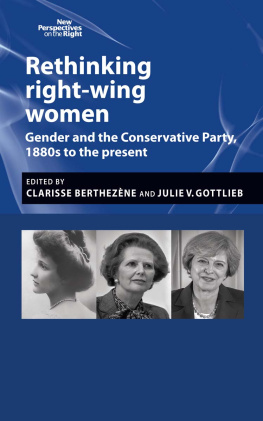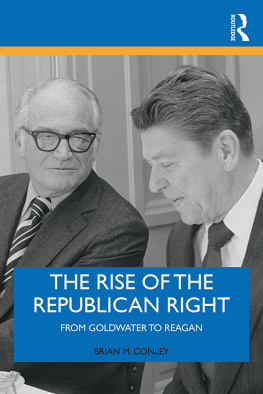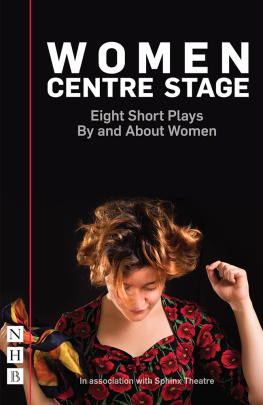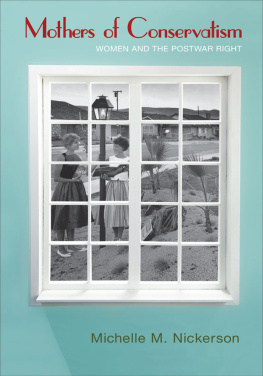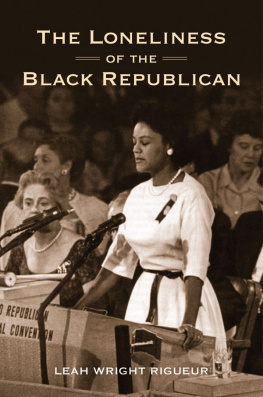Goldwater Girls to Reagan Women
ABBREVIATIONS
CCFRW | Cobb County (Ga.) Federation of Republican Women |
GFRW | Georgia Federation of Republican Women |
EAC | Educational Advisory Committee |
ERA | Equal Rights Amendment |
GOP | Grand Old Party, another name for the Republican Party |
IWY | International Womens Year |
IWY CRC | International Womens Year Citizens Review Committee |
NAACP | National Association for the Advancement of Colored People |
NFRW | National Federation of Republican Women |
NOW | National Organization for Women |
OLAE | Operation Lend-An-Ear |
RNC | Republican National Committee |
STOP ERA | Stop Taking Our Privileges Equal Rights Amendment |
WNDC | Womens National Democratic Club |
WIG | Write-In Georgia, gubernatorial campaign for Ellis Arnall, 1966 |
PROLOGUE
The GOP Has Been Asleep
Mrs. Hattie Greene took the occasion of the Abraham Lincoln birthday dinner in 1954 to announce that women are going to resurrect the Republican Party in Georgia. She proclaimed that women have decided to give all to awaken the Republican Party that has been asleep for 20 years.
The previous year, Greene had joined eight other women in the Auburn Avenue neighborhood of Atlanta to establish the Metropolitan Republican Womens Club. White women had tried, unsuccessfully, to charter clubs in the state during the previous decade, but only Greenes club thrived.
The nine original Metropolitan Club members were African American women living and working in Atlantas Auburn Avenue neighborhood. Club history records that the women recognized a need for a new organization and a necessary change in Georgia politics, especially one that would encourage participating in the Republican Party and two-party politics. Unable to meet the requirements for statewide status, the women of the Metropolitan Club applied first for single-club membership. The NFRW based state organization on the number of organized counties, meaning that 95 of Georgias 159 counties would need chaptersan unimaginable goal in a Jim Crow, one-party state.
As educated, upper-class, and politically active urban citizens, the women of the Metropolitan Club were some of the few registered African American voters in Georgia. Some, like Hattie Greene, came from families who had been active in the Republican Party since Reconstruction. Many held degrees from
In 1953, the same year the Metropolitan Republican Womens Club was chartered, Hattie Greene and two other members traveled to the nations capital for the annual meeting of the NFRW, putting them among approximately 30 Negro women of the hundreds of attendees from around the nation. Other African American women came from New Jersey, Texas, Illinois, Ohio, New York, and CaliforniaGreene, Mrs. Birdie Wallace, and Mrs. W. A. Scott were the only African American attendees representing the Deep South. By identifying themselves as Mrs., these women claimed a title of respect likely denied to African American women in most Georgia political meetings.
The Atlanta women marveled at the integrated events planned, including a visit to the White House, where the First Lady greeted them. Later, they attended a luncheon at which President Eisenhower emphasized womens roles in his campaign. Senator Margaret Chase Smith, the only woman in the Senate, introduced the six Republican women then serving in the House of Representatives. Eisenhower had recently nominated an African American woman as assistant to the secretary of the Department of Welfare, and one of the attendees from Chicago marveled, Lincoln, here we are! You gave us our freedom and Eisenhower has given us equality under law!
Excluded from the Democratic Party, generations of Georgias African American business leaders clung to the Republican Party for a voice. While not central players in the national GOP, these African American women had a place at the table. The First Lady hosted them at the White House when the Georgia Democratic Party would not seat them at all.
African American women organizing the GOP in Georgia faced obstacles of racism, sexism, and partisanship; all the power structures in Georgia sought to prevent their progress. Reporting to the Republican National Committee (RNC), Greene wrote that there is tremendous work to do... but a small group of Republican women here are determined. She told national GOP leadership that the women would require yours & Gods help.
The women of the Metropolitan Club were well connected within Atlantas
True to Hattie Greenes promise that the women would awaken the Georgia GOP, the women continued organizing in the state and with other state organizations. In 1955, the NFRW planned a regional meeting of southern Republican women in New Orleans. The event marked the first time that the Republican women have gone into the Deep South for a conclave. The NFRW hoped to double its membership to one million by the 1956 campaign season and looked to the South for its potential new members. The African American women of the Metropolitan Club were at the fore of organizing the GFRW throughout the state.
By 1960, an interracial group of Georgia Republican women worked together to support the presidential campaign of Richard Nixon. Mrs. Lottie Harris joined a white woman, Mrs. John Pendergrast, to present plans for campaign activities at a meeting of Republican women at the Phyllis Wheatley YWCA just a couple of weeks before the election.
While white Democratic women supported local and state campaigns in Georgia and elsewhere, they did not enjoy the national network that characterized the NFRW. The Democratic Party did not have an organization equal to the NFRW until decades later. Founded in 1927, the Womens National Democratic Club (WNDC) was a social club first and political club second. It was simply
While the GOP welcomed African American members, the South remained inhospitable to the Republican Party. Georgias GOP was especially late. Neighboring Alabama had an active Republican Party that ran viable candidates for governor in 1954 and Senate in 1960. Tennessee voters even sent two Republican congressmen to Washington. Five other southern states ran Republican candidates that won up to a third of the total vote. Southern Republicans did not win often, but they showed on the ballot in all but the deepest South states of Georgia, Mississippi, and South Carolina. The first real toehold southern Republicans found came in presidential elections. Dwight Eisenhower pulled 48.1 percent of the southern vote in 1952 and slightly more than that in 1956. He carried Florida, Tennessee, Virginia, and Texas in both elections and added Louisiana in 1956.
Though Metropolitan Club members might overcome restrictive voter laws and register as Atlanta voters, they were still limited by the county-unit system. Under this system, counties received unit votes in the all-white Democratic primaries, similar to the national electoral college system. The eight most populous counties received six votes each. The next thirty had four votes each. The remaining 121 counties, the states least populated, each had two votes. In 1960, this resulted in rural counties, which had 32 percent of the population, having 59 percent of the vote. Urban areas, in contrast, had 41 percent of the population but only 12 percent of the vote. The tiny Georgia GOPs power largely lay in these underrepresented urban areas. Until 1962, state elections operated on a county-unit system that heavily favored rural districts. Federal courts ruled the county-unit system unconstitutional even as suburban areas boomed. Over the next few years, three factorsAfrican American registration, the end of the county-unit system, and growing suburbanizationcracked open an opportunity for the development of a two-party system in 1964.
Next page


